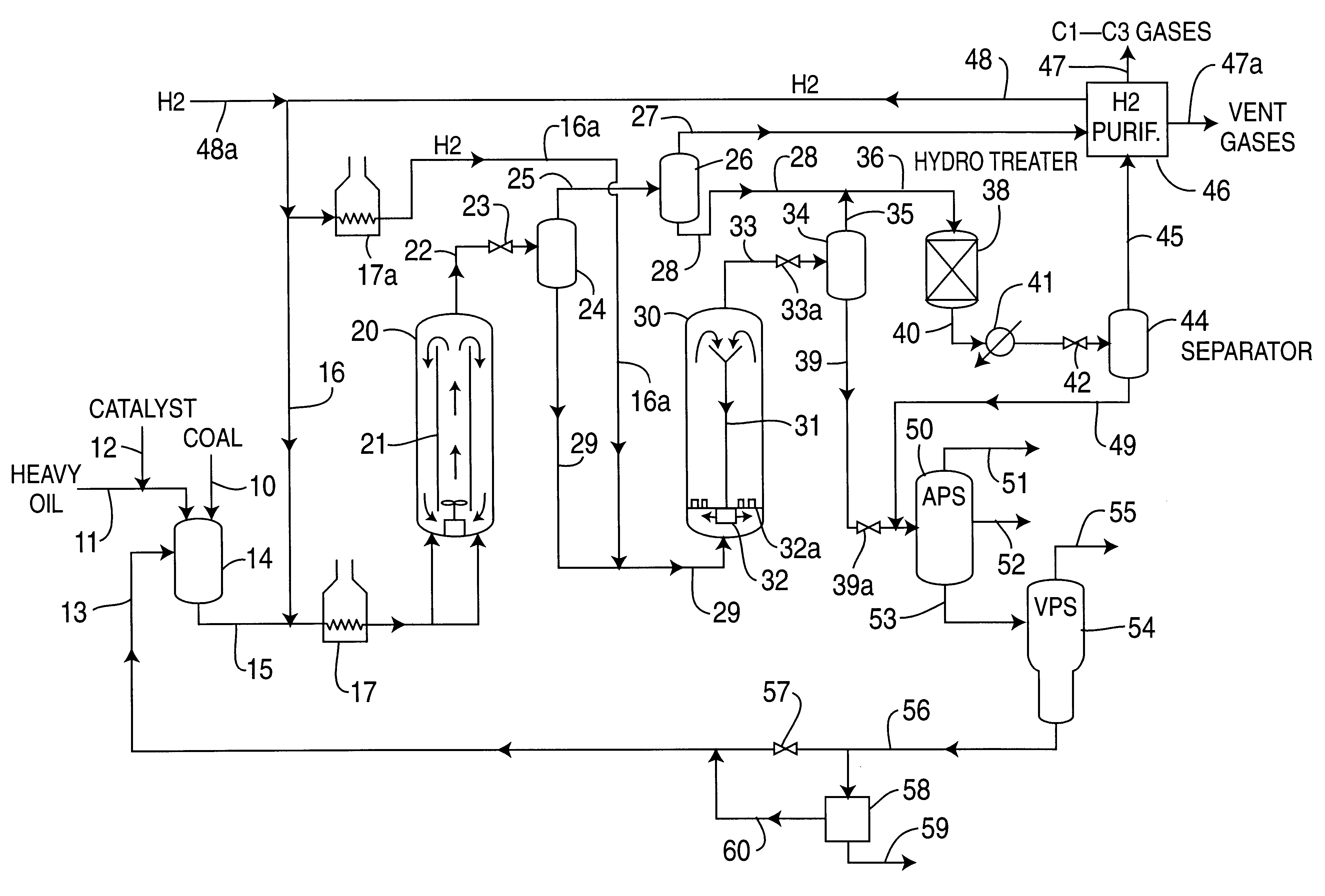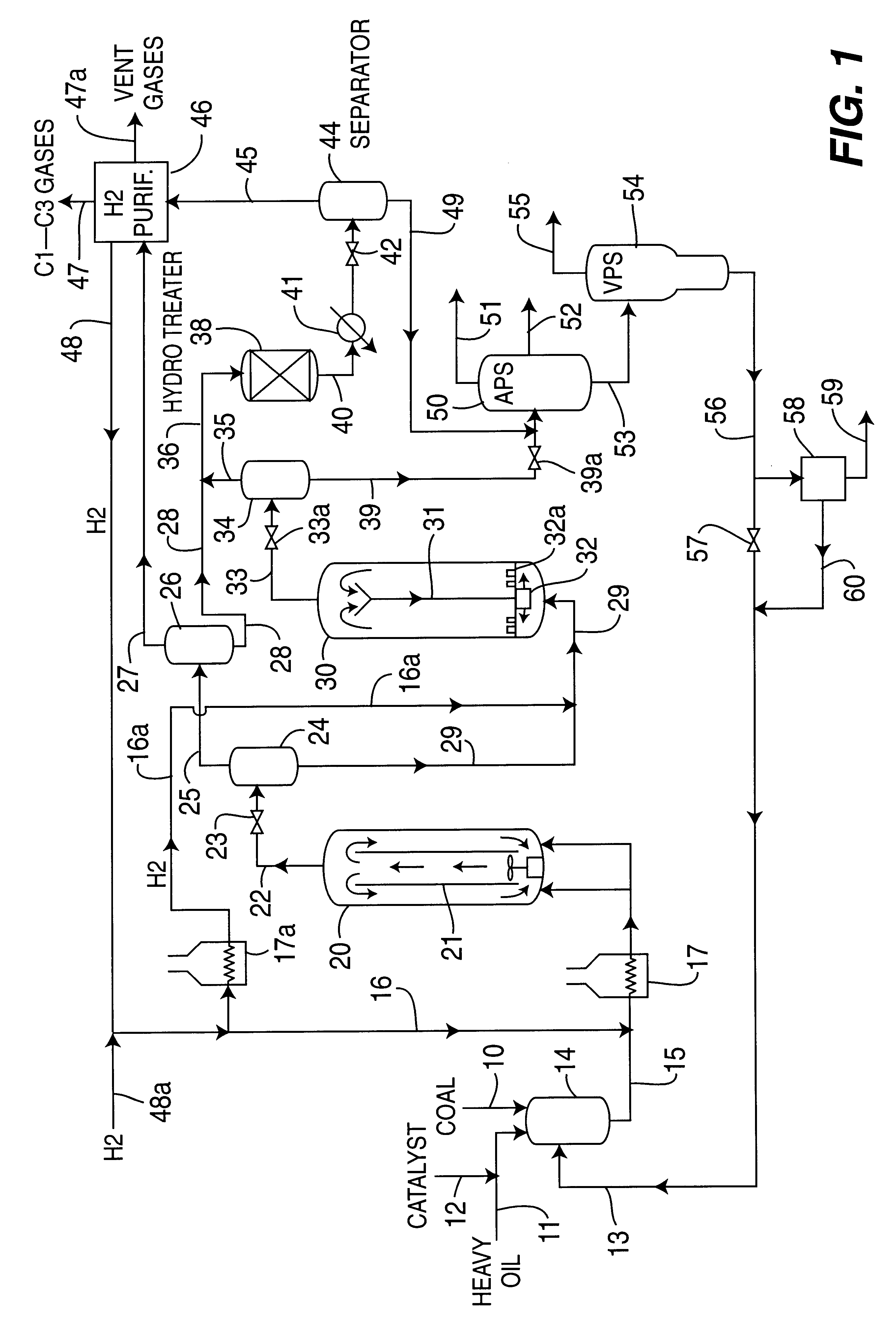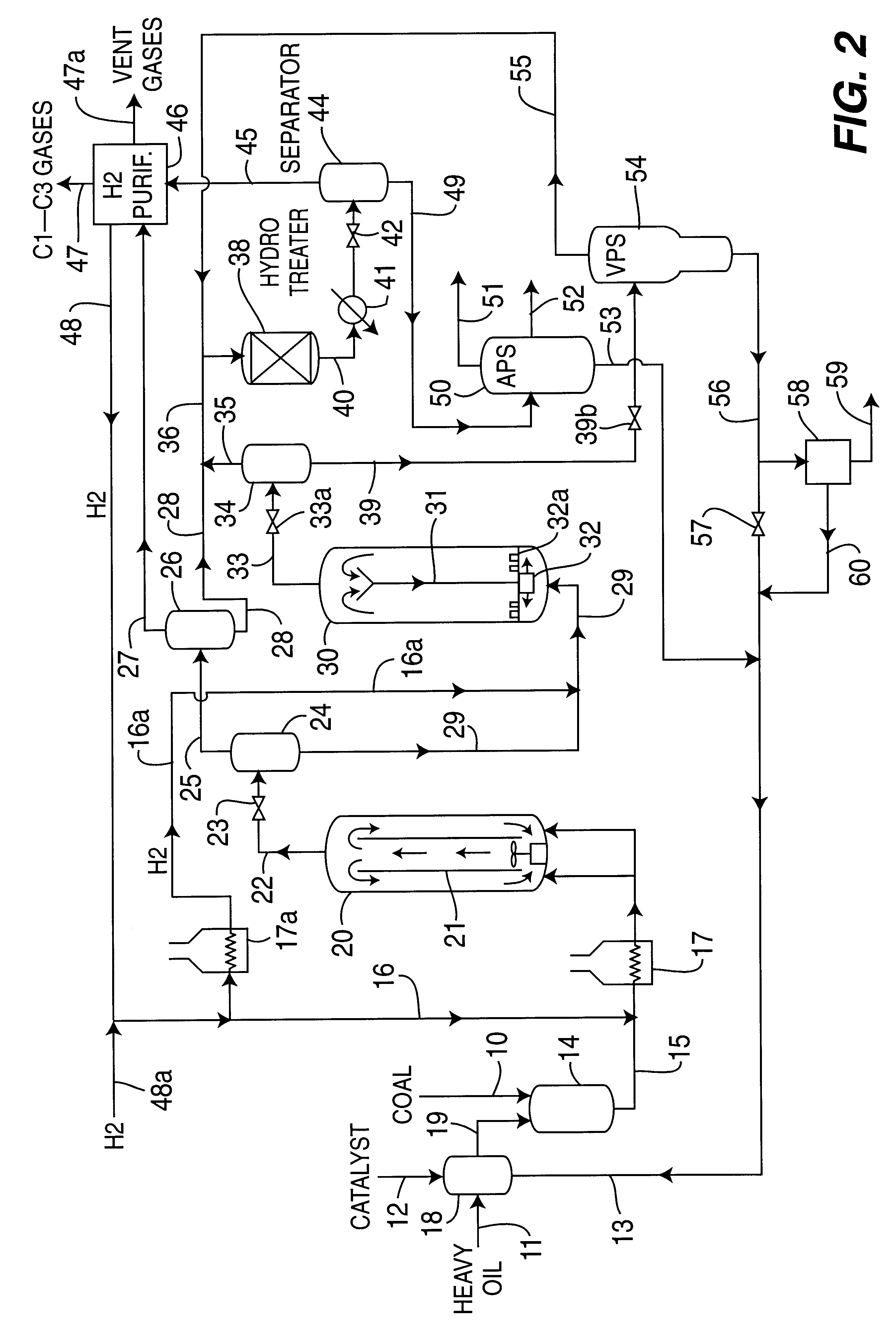Catalytic multi-stage process for hydroconversion and refining hydrocarbon feeds
a hydroconversion and hydrocarbon feed technology, applied in the direction of catalyst activation/preparation, metal/metal-oxide/metal-hydroxide catalyst, physical/chemical process catalyst, etc., can solve the problem of low effectiveness of known iron-based catalytic compounds, poor contact with feed materials, and particulate support catalysts. problem, to achieve the effect of enhancing distillate yield and quality and high quality
- Summary
- Abstract
- Description
- Claims
- Application Information
AI Technical Summary
Benefits of technology
Problems solved by technology
Method used
Image
Examples
example 2
A further comparison was made for a catalytic two-stage reactor hydrogenation process with and without interstage phase separation for a blended feedstream of 35 wt. %sub-bituminous coal and 65% Hondo petroleum resid. The results are provided in Table 3 below.
TABLE 3 Without With Interstage Interstage Separation Separation Normalized Yields, w % MAF Feed Relative Reaction Severity 43 46 C.sub.1 -C.sub.3 Gases 6.2 7.3 C.sub.4 -C.sub.7 Liquid 9.7 9.3 Naphtha (C.sub.4 -3250.degree. F.) 17.7 21.6 Mid-Distillate (350-650.degree. F.) 31.5 37.3 Heavy Distillate (650-975.degree. F.) 26.7 20.1 Resid (975.degree. F..sup.+) 10.4 7.5 Process Performance, wt. % MAF Feed Coal Conversion 92.6 95.7 975.degree. F. Resid Conversion 85.4 89.8 C.sub.4 -975.degree. F. Product Yield 75.8 79.1 H.sub.2 Consumption 4.45 4.78
From these results, it is seen that generally higher conversion of the blended coal and resid feed and higher C.sub.4 -975.degree. F. product yield are achieved at similar reaction condi...
example 3
Utilizing an in-line catalytic hydrotreating step for the combined two staged reactor effluent vapor and light liquid fraction streams in this catalytic two-stage hydrogenation process is a very effective and economical step for reducing heteroatom content and aromatics in the product oil. The exothenm available from hydrogenation of the coal or heavy hydrocarbon oil feed and the high hydrogen partial pressure which is available from the prior reactors is utilized effectively in the catalytic in-line hydrotreating reactor, and a significant $3-$6 / bbl improvement in product oil value is realized. Typical comparative results for in-line catalytic hydrotreating of a naphtha fraction derived from two-stage catalytic reactor operations on a sub-bituminous coal feed are shown in Table 4 below:
TABLE 4 Quality Of In-line Hydrotreated Naphtha Fraction Product Characteristics In-line Hydrotreating No Yes .degree.API Gravity 36.2 39.9 Carbon, wt. % 86.6 86.3 Hydrogen, wt. % 13.3 13.7 Nitrogen,...
example 4
A direct comparison of a known prior catalytic two-stage liquefaction (CTSL) process using two staged close-coupled ebullated bed reactors each containing a particulate supported type catalyst or a dispersed type catalyst compared with the present catalytic two-stage reaction process utilizing highly dispersed iron-based slurry catalyst together with interstage phase separation and in-line catalytic hydrotreating step for a sub-bituminous coal feed is shown below in Table 6.
TABLE 6 Catalytic Two Stage Coal Liquefaction of Sub-Bituminous Coal Feed Supported Dispersed Particulate Catalyst GelCat .TM. Process Arrangement Catalyst Iron / Moly Iron / Moly / P Run Designation CC-1 CMSL-6 PB-04 Interstage Phase Separation None None Yes In-Line Catalytic Hydrotreating None None Yes Performance, wt. % MAF Coal C.sub.1 -C.sub.3 Gases 8.0 8.0 7.9 CO.sub.x 0.5 4.5 6.5 H.sub.2 O 18.5 14.0 12.1 Coal Conversion 86.4 94.1 93.2 C.sub.4 -975.degree. F. Liquid Fraction 62.6 63.1 67.5 975.degree. F..sup.+ Fr...
PUM
| Property | Measurement | Unit |
|---|---|---|
| Time | aaaaa | aaaaa |
| Partial pressure | aaaaa | aaaaa |
| Partial pressure | aaaaa | aaaaa |
Abstract
Description
Claims
Application Information
 Login to View More
Login to View More - R&D
- Intellectual Property
- Life Sciences
- Materials
- Tech Scout
- Unparalleled Data Quality
- Higher Quality Content
- 60% Fewer Hallucinations
Browse by: Latest US Patents, China's latest patents, Technical Efficacy Thesaurus, Application Domain, Technology Topic, Popular Technical Reports.
© 2025 PatSnap. All rights reserved.Legal|Privacy policy|Modern Slavery Act Transparency Statement|Sitemap|About US| Contact US: help@patsnap.com



